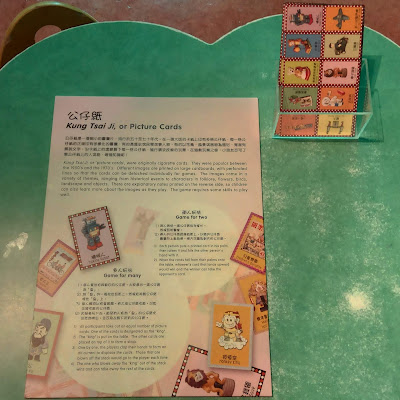01-022
Kung Tsai Ji
Last
week, I took my wife and kids to the Hong Kong Heritage Museum. It is my first
time visiting there.
The
museum sits on a beautiful river bank in Shatin. It is in between 2 metro
stations and is quite far away from my home. For me, going there is not as
convenience as going to other museums. And that is why I have never been to
there before even though the museum has been opened for more than 2 decades.
As
its name tells, the museum mainly focuses on the heritage of Hong Kong. And as
an essential part of every culture, there is a section about toys inside. I
found many old toys that I have been playing during my childhood. Good old
memories came back. I have forgotten most of them. Most of the exhibits are not
possible to find now. And among them is a very special card game called “Kung
Tsai Ji” (公仔紙).
“Kung
Tsai Ji” literally means picture cards. It is organized from cigarette cards.
In the early 20th century, competition between tobacco factories was
fierce. To attract more customers, manufacturers started to include a small
piece of cardboard in each cigarette pack. Original cigarette cards measure 3.7 cm
× 6.7 cm. “Kung Tsai Ji” circulating here are usually smaller
in size, at around 3cm x 5cm approximately.
Theme
of cigarette cards can be anything from animals to plants and to Hollywood
stars. All are colourfully printed. Like stamps, cigarette cards are intended
for collection only. People smoked more simply because they want to
collect more cards. Some became loyal to a certain cigarette brand because they
wanted to collect the whole set. Manufacturers are very smart in marketing!
Then somehow those cards ended up in children’s hands. And instead of just collecting, children created a way to play with them. “Kung Tsai Ji” then became a popular “card game” among boys. Actually, instead of calling it a card game, “Kung Tsai Ji” is more a dexterity and coordination game.
Parents bought the whole sheet back home and cut them into many smaller cards. Children would get a piece from their parents if, for example, they got good grade in exam.
According
to the museum, “Kung Tsai Ji” was popular until early 80s. But I have no memory
of playing them. My mum did, but cannot remember how to play. Luckily, the
museum told me how.
Like
many traditional games, the ways of playing vary. But the museum is run by the
government, I considered rules published by them are the official ways of
playing.
Will
I play “Kung Tsai Ji” with my kids?
No
way! “Kung Tsai Ji” does not belong to this age. Some people are still printing
them but you can hardly find anyone playing. Children all stick their eyes on
Nintendo Switch nowadays.
General
Information
|
Player |
2+ |
|
Playing Time |
5 to 10 mins |
|
Age |
5+ |
|
Year Released |
1950s? |
|
Designer |
(Public Domain) |
|
Publisher |
(Public Domain) |
|
Family |
Dexterity and coordination |
|
Score |
? |
Specifications
|
Card size |
Not specific, down to the printer. |
|
Deck size |
Not specific, down to the printer. |
|
# of suits |
n/a |
|
Details |
Not specific, down to the printer. |
The game play
Game for Two
- Each person puts a printed card in his palm, then raises it and hits the other person’s hand with it.
- When the cards fall from their palms onto the table, whoever’s card that lands upward would win and the winner can take the opponent’s card.
Game for many
- All participants take out an equal number of picture cards. One of the cards is designated as the “king”.
- The “king” is put on the table. The other cards are placed on top of it to form a stack.
- One by one, the players clap their hands to form an air current to displace the cards. Those that are blown off the stack would go to the player each time.
- The one who blows away the “king” out of the stack wins and can take away the rest of the cards.
Where
to buy?
In the
Hong Kong Heritage Museum, you can get a sheet of “Kung Tsai Ji” for free. Drop
me a message if you are interested.
Go back to the Lobby ...



